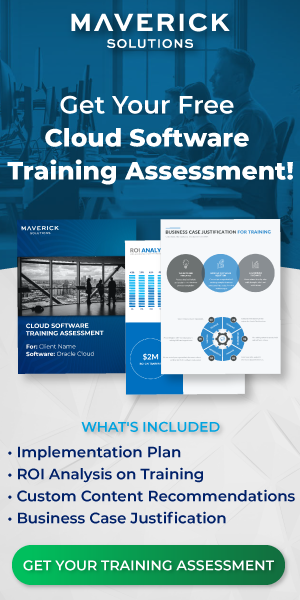In the last few decades, there has been a shift to the Cloud. Apple users can store their data and files in iCloud, Google users can store their files in their Google Drive, even Oracle software is in the Cloud. The Cloud allows people to access their files anytime, anywhere. People are starting to get on board with keeping their pictures in the Cloud. Businesses are also starting to feel more confident in Cloud technology, and they are buying Cloud software. So what is Cloud training? And what are the benefits of Cloud training?
For the purposes of this article, we will focus on enterprise training and learning.
Traditional Learning and Training
What is traditional learning and training? Traditional learning and training is likely what you think of when you think of learning a new skill or receiving on-the-job training.
Traditional learning and training involve an instructor, a shared, physical location, and one or more learners. It also often involves physical copies of the training material. Traditional training can take the form of one-on-one, in-person sessions.

Cloud Training
Cloud training, or e-learning, is simply training resources that are in the Cloud. Learners have 24/7 access to the training resources, as long as they have a wireless connection. Cloud training can come in various formats, such as:
- Documentation
- Video Demos
- Interactive, practice simulations
- Audio Files
The various formats account for people’s learning styles. People who learn best by seeing can watch video demos, while people who learn best by doing can go through the interactive, practice simulations.
Then vs. Now and the Benefits of Cloud Training
While traditional training is comfortable and familiar, there are numerous benefits of Cloud training that traditional training does not offer. Traditional training, while great in some situations, has its limitations. Benefits of Cloud training include:
- Learners can move at their own pace.
- Businesses can continue to grow even when the whole company is working remotely.
- Learners can choose the training format that works with their learning style.
- Cloud, subscription training is always updated.
We will dive into each of the benefits of Cloud training.
Self-paced Learning
With traditional training, learners had to go at the same pace as their peers, or at a pace dictated by their instructor. Cloud training allows learners to move through the training resources at their own pace. If they need to take extra time to review and understand or practice a concept, they can. Conversely, if a learner understands the concept quickly, they can move forward without waiting for their peers or their instructor.
Each individual learner benefits from Cloud training because they can ingest the training resources well at the pace that works for them. But how does self-paced learning benefit the business as a whole?
A less obvious benefit of self-paced learning is that an instructor does not have to be present for the learner to go through the training resources. This means employee absences will not hurt your training investment. For example, let’s say your business wants to train ten employees. Your business invests in a full-day, instructor-led training course for those ten employees. The day of the instructor-led training course arrives, and Tom is absent due to sickness and Beth has to leave in the middle of the day due to a family emergency. Now, only eight employees have been fully trained, and the other two have to attend a future training session.
Conversely, if your business invests in Cloud training for ten employees, those ten employees can go through the training resources at their own pace. Tom, who is out for sickness, can go through the training documentation when he gets back into the office. Beth, who had to leave in the middle of the day, can pick up where she left off.
Scalability and Remote Employees
Earlier, we said that traditional learning involves an instructor, a shared, physical location, and one or more learners. Because traditional learning involves an instructor and a shared, physical location, it’s difficult to scale. Let’s break that down why that is the case.
A shared, physical location has capacity limitations. Put simply, a room can only fit so many people. Traditional training at enterprises involved training the trainer. Instructors would go on-site to the company and train team leads via knowledge transfer. Then, the team leads would train their team. This doubled the amount of time team leaders spent on training instead of focusing on strategic initiatives. Additionally, the team leaders only had a fraction of the expertise of the instructor or subject matter expert.
With traditional training, an instructor has to be present to lead the instructor-led course. This means a subject matter expert has to schedule a day to travel to the company.
Conversely, Cloud training is on-demand. Due to the Covid-19 pandemic, many businesses have gone fully or partially remote. Businesses that traditionally employed shadowing to onboard employees could not do that because everyone was at home. Cloud training allows businesses to grow whether their employees are at the office or at home.

Learning Style
A learning style is the style by which a person retains information best. People have one of four learning styles:
- Visual
- Auditory
- Reading/writing
- Kinesthetic
In a traditional training situation, an instructor does not have the time to teach the same concept in each of the four learning styles. This means some learners will absorb most of the information, and some learners will still feel lost.
Learners are at the mercy of their instructor. If the subject matter expert prefers to teach by reading a presentation, only the learners whose learning style is auditory will feel confident about the training content. Cloud training, on the other hand, allows each learner to pick the learning style that works best for them. If a learner learns best by doing, they can use interactive, practice simulations to learn processes. Or if a learner learns best by reading, they can read through the training documentation.
Updated Training Content
Traditional training is training that is delivered at a single point in time. The instructor likely brings along handouts for each learner to reference after the instructor-led session. Just like that training session is a single point in time, the handouts are relevant for a single point in time.
All software goes through updates. On-premises software goes through updates, but the software buyer can choose when to buy the newest version of the software. Cloud software goes through updates, and the vendor pushes the updates to the customers. In either case, software undergoes updates.
The software is not the only component of a business that undergoes updates. The business itself goes through updates. As time goes on and businesses grow, their processes have to evolve. Training has to keep up with the changes at a company. Traditional training that is done for a single point in time cannot keep up with a scaling company.
Cloud training, on the other hand, is built for growth and innovation in mind. Since the training documents live in the Cloud, they can be updated to make sure the learners are accessing only the most up-to-date training information.[/vc_column_text][vc_column_text]
Before You Go
The shift to Cloud technologies has led to a new normal, and this change has been good. Cloud software allows enterprises to stay at the forefront of innovation. For example, when Oracle builds new features into their Oracle Cloud Suite of products, your team has access to all of those new efficiencies. However, Cloud technology is a double-edged sword. The same software that can keep your company at the forefront of innovation can also be the reason your team is falling behind. Your team needs to be equipped with on-demand and up-to-date training.
That’s what Maverick Solutions discovered. Maverick Solutions has been providing training for Oracle since 1999. Maverick provided traditional training for Oracle until we realized that Cloud training, or what we like to call Training as a Service, was best in a world of Cloud technology. We created training that updates as Oracle updates their software. We made sure that learners can access the training whenever they needed to, and we made sure to give learners various modes of learning so they can learn the information faster. Maverick Solutions’ clients have been able to continue their business with no disruptions even when their team had to work remote.
Before Maverick Solutions, one of our clients used to train new employees by having the new employee sit next to another employee and go over a big binder of training material. Their traditional onboarding process took about a week. With Maverick Solutions, our client was able to onboard employees by directing them to ENGAGE by Maverick. The new employees completed the training in a few days.
ENGAGE by Maverick is our Cloud training offering. ENGAGE is Maverick Solutions’ subscription-based training offering on all Oracle Cloud applications. It is fully customizable, comprehensive, and available 24/7/365. If you want to learn more about our Cloud training offering and how Maverick Solutions can fit into your organization’s current or future Oracle projects, speak with one of our training experts today!



